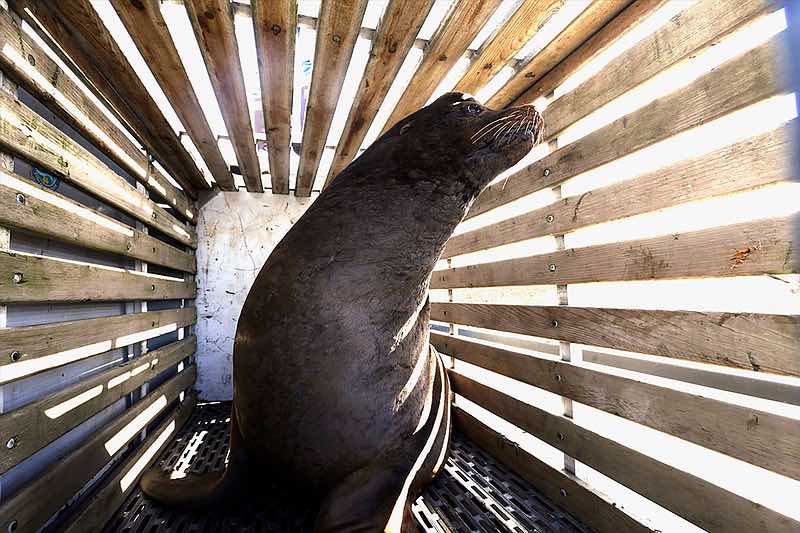forum
library
tutorial
contact

Congress Must Act -- Again --
to Save Salmon from Hungry Sea Lions
by Editorial Board
Seattle Times, May 25, 2018
|
the film forum library tutorial contact |

|
Congress Must Act -- Again --
by Editorial Board
|
The problem with sea lions gorging on threatened fish has moved far beyond the Ballard Locks.
Congress must take action to protect species along the Columbia River and its tributaries.
 Government agencies spend hundreds of millions of dollars annually trying to preserve threatened salmon and steelhead runs in the Columbia River Basin.
Government agencies spend hundreds of millions of dollars annually trying to preserve threatened salmon and steelhead runs in the Columbia River Basin.
Yet in recent years, a growing population of hungry sea lions has jeopardized all of that investment and hard work.
These marine mammals have gobbled up thousands of prized fish as they return home to spawn -- and, in some cases, they are putting certain fish populations on the road to extinction.
Maintaining these fish runs is vital not only for recreational fishing but also for Northwest tribes. For them, spring Chinook in particular play an important role in traditional ceremonies.
Congress needs to safeguard the public's investment in conserving these vulnerable salmon and steelhead runs along the Columbia. Republicans and Democrats must come together this year to pass legislation making it easier to lethally remove some of the sea lions.
That will mean relaxing a section of the 1972 Marine Mammal Protection Act, which right now requires fish and wildlife agents to go through a laborious process of observing, trapping, branding, releasing and again observing the predatory sea lions several more times before finally granting permission to euthanize them.
For their part, California sea lions are doing just fine. The mammals' U.S. population has rebounded from an estimated 30,000 in the 1960s to nearly 300,000 today -- a testament to the success of conservation efforts.
But their resurgence has come at a cost. Since the early 2000s, more and more male sea lions have migrated up the Columbia River, setting up residence below the Bonneville Dam. As many as 195 California sea lions, as well as a growing number of Steller sea lions, have been spotted at the dam in a single season, with more than 100 animals sometimes congregating there in a single day.
That's a perfect place for delectable meals of rich, wild salmon.
Last year, the animals consumed an estimated 9 percent of the steelhead and almost 5 percent of the spring Chinook trying to cross over the dam. Both species are protected under the Endangered Species Act.
Just as concerning to fish and wildlife officials is what seems to be happening on other parts of the river and its tributaries. According to researchers with the National Oceanic and Atmospheric Administration, about 45 percent of spring Chinook inexplicably disappeared between the mouth of the Columbia River and the Bonneville Dam in 2014, even after accounting for losses from fishing. Last year, an estimated 24 percent of the fish run similarly disappeared. The researchers said sea lion predation was most likely to blame.
The problem crosses state borders. In Oregon, state fish and wildlife scientists say that on peak days, up to 40 California sea lions line up at the Willamette Falls to feast on returning fish. They warn that if the sea lions continue to prey at these levels, there is a 90 percent likelihood that at least one of the river's wild steelhead populations will go extinct. Only 512 returning steelhead crossed the Willamette Falls last year, down from about 20,000 in 2000.
The situation is urgent. Washington and Oregon's members of Congress should work together to solve this problem. Delay could have dire consequences, as history has shown.
In the late 1980s and early 1990s, federal officials dithered about how to address the sea lions that were chomping on steelhead at Seattle's Ballard Locks. By the time Congress acted to allow lethal removal of some of the animals, the Lake Washington stock of winter steelhead was essentially destroyed.
U.S. Rep. Jaime Herrera Beutler, R-Battle Ground, has proposed legislation that would ease the road to removing some of the sea lions that are threatening today's protected fish. Meanwhile, wildlife managers in Oregon and Washington have joined with tribal leaders to propose smart changes that would help balance concerns about maintaining healthy sea lion populations. They estimate they could solve the problem by removing about 200 of the 4,000 California sea lions that occupy the Columbia River Basin, along with a much smaller number of Steller sea lions.
Democrats, especially Washington Sen. Maria Cantwell, who serves on the Commerce Committee, now need to shepherd this important legislation through Congress this year.
For many of the fish fighting to return to their spawning grounds, another year of delay means one year closer to extinction.
Related Pages:
Sea Lions Feasting on Columbia River Steelhead by Brian Neale, KXLY, 3/8/18
Ocean Predators by John Harrison, NW Council, 1/16/18
Related Sites:
Final 2016 Pinniped Report: Sea Lion Salmon Take Astoria To Bonneville Dam Could Be 20 Percent Of Run by Staff, Columbia Basin Bulletin 6/17/16
Evaluatin of Pinniped Predation on Adult Salmonids and Other Fish in the Bonneville Dam Tailrace by Kyle Tidwell, Bjorn van der Leeuw, Lindsay Magill, Brett Carrothers, and Robert Wertheimer, USACOE 5/5/17
learn more on topics covered in the film
see the video
read the script
learn the songs
discussion forum
